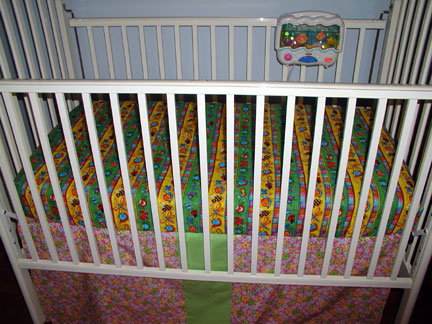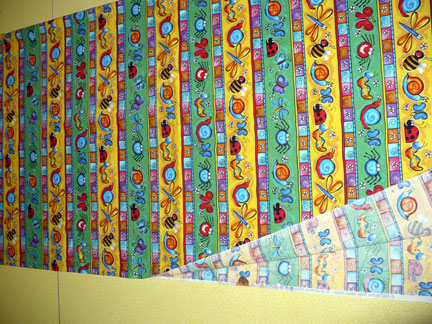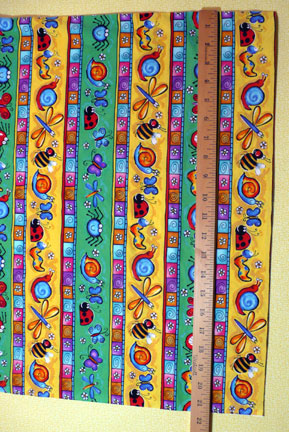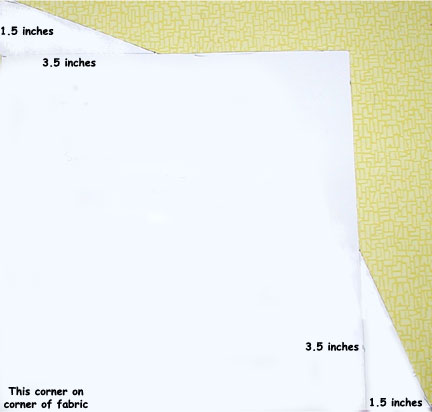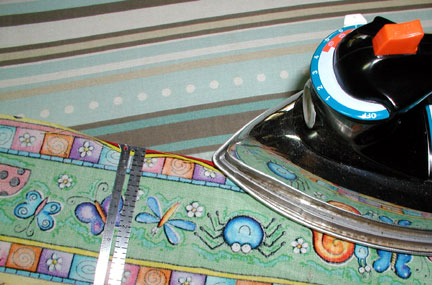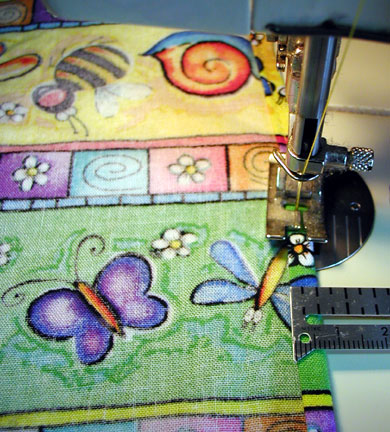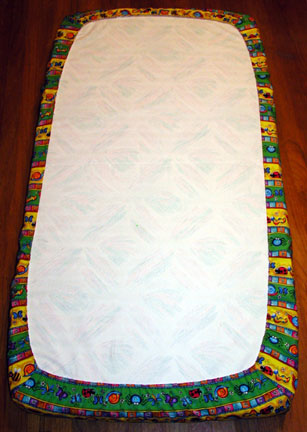Rosie’s Crib Sheet Tutorial
by Jeannie
After finding out that we were pregnant with our first baby, I began the long and fun process of collecting all of the things that a new human needs to survive. First on the list? A CRIB of course! Beyond the crib (which we found at a consignment sale, along with the crib mattress) a baby needs crib sheets. Happily, Rosie has a talented grandma who was more than happy to provide her with many of the essentials of baby survival – a quilt (with strict instructions to USE it), a few totally cute outfits and 4 crib sheets.
Rosie’s Grandma is a sewing kind of lady and back when I was a kid, money was tight and so, well, she sewed. Beyond making nearly all of our clothes that weren’t hand-me-downs, she also devised a pattern for a crib sheet. Back in the day, people actually made their own sheets for their big beds, too, and she adapted this pattern from one of those patterns.
The pattern is easy, suitable for a beginning sewer, and takes about 1 hour, or several days if you already have a baby who doesn’t like to sleep. Not that I know anything about that at all… What you will need for equipment is a basic sewing machine capable of doing zig-zag and straight stitches, an iron and ironing board and a few basic sewing things, like pins and scissors. For fabric, you can buy new fabric from any fabric store OR do the environmentally correct (and infinitely cheaper!) thing and repurpose an old grown up sized bed sheet. (Or even more fun, take one of your old childhood sheets and make your baby a sheet out of that!) Flannel sheets for a crib could be wonderful, too, especially for winter babies!
Fabric from the store generally runs anywhere from $2-8/yard… If you’re going to Hobby Lobby, Joanns or Michaels, make sure you use one of their nifty coupons to get 40% off the fabric price. Walmart has fabric too, but in general, it’s thinner and won’t make as nice of a sheet. Of course, the best thing to do if buying new fabric is to support locally owned fabric shops!
Used bed sheets, on the other hand, can be free (from your own closet) or about $1 per sheet. I find them at thrift stores and garage sales… One hint on thrifted sheets – If, like at my Salvation Army thrift store, they fold the sheets up and tape them shut with masking tape – un-tape them and check out the middle. I’ve found several sheets that looked nice and pretty folded up only to be pretty ookey in the middle. Check out the chart in the instructions to see about how many crib sheets you can get out of an adult sized sheet.
Either way, PLEASE be sure to pre-wash and dry your fabric before making this for your baby! Wash in hot water and dry on hot to make sure that it shrinks as much as it is going to and to eliminate any excess dyes or cooties that might harm the baby. Cooties especially from thrifted sheets because, well, you know what happens on sheets, just saying…
Materials:
-
Fabric from store – 2 yards
OR
thrifted sheet
-
3 yards (1 package) of ¼ inch stretch elastic, part cotton part rubber
-
thread to match the fabric
-
cardboard to make pattern, about 12 inches square (an old pizza box works great!)
-
scissors, yard stick…
Steps:
For Store bought fabric:
Fold fabric in half lengthwise. It doesn’t matter if the fabric is wrong or right sides together – either will work fine. Lay the fabric rectangle out flat on your cutting surface (in my case, my kitchen table). Make sure edges are aligned, the selvages should be on the long edges.
Cut the fabric on the end so that this edge is straight, forming a 90 degree angle with the long edge. I use my rotary cutter, ruler and mat, but you can also line it up with something you know is square, like the tiles on your kitchen floor, and cut it with regular fabric scissors.
Measure the fabric on the short side using a yard stick or tape measure and double this – this is the width of your fabric. Find the width of your fabric in the chart below and note the length given below it. This is how long you will cut your fabric.
* All measurements below are in inches!
|
width – of fabric |
41 |
42 |
43 |
44 |
|---|---|---|---|---|
|
length – of fabric |
66 |
67 |
68 |
69 |
|
square size |
7 |
7.5 |
8 |
8.5 |
Measure the fabric to the length indicated and again, cut the fabric so that it is square. For example, if my fabric is 43 inches wide, I will cut my fabric to a length of 68 inches.
*** Using the chart, select the correct pattern size to cut out. To make the pattern, on your pizza box, draw a square of the appropriate size (8 inches for a 43 inch wide fabric), then add the triangles to the corners. The triangle should be 1.5 inches wide and 3.5 inches tall. Refer to the picture below for reference.
Cut out the paper pattern and place it on one corner of your rectangle of fabric with the wings of the pattern along the edges of the fabric. The folded edge of the fabric should be at the top and the two open corners at the bottom. Use a pen that writes on fabric (any pen will do, even a sharpie) and trace around your pattern. Repeat this process at the other end of the fabric rectangle.
Cut out both layers of fabric following the traced lines. Save this scrap fabric for later craftiness.
Unfold your fabric – it should look like this with the four corners missing.
FOR THRIFTED SHEET FABRIC
To maximize the number of crib sheets that you can get out of one adult sheet, you’re going to have to do a bit of layout vizualizing. I personally have made a large pattern using the back side of wrapping paper, but newspaper will work just as well. Then, I laid it out on the sheet before doing any actual cutting. To make a newspaper pattern, tape together sheets of paper and then meaure out a rectangle 43 by 68 inches. The 43 inch wide size is probably the better size as it allows for more fabric to fold under the crib mattress after the sheet is made, but if it doesn’t fit, try the 41 inches out, it works just as well.
Cut out the newspaper rectangles and place on your sheet (which is probably on the floor) and manuever around until you can maximize the number of crib sheets cut out. As sheets do vary a bit in size, it’s hard to give for sure estimate but… the chart below should give you an idea of how many crib sheets you might get out of an adult sheet (and this is an estimate, I havn’t tried all of the sheet sizes). Also, if there is any particular design that you want centered on the crib sheet (or stains that need to be avoided), now is the time to do so, just be sure to keep the edges all straight with the grain (edge) of the fabric. You can then pin the pattern to the sheet and cut out along the edge.
|
|
fitted – standard size |
number of crib sheets from fitted |
flat – standard size |
number of crib sheets from flat |
|---|---|---|---|---|
|
Twin |
39 x 75 |
0 |
66 x 96 |
2 |
|
Twin XL |
39 x 80 |
0 |
66 x 102 |
2 |
|
Double |
54 x 75 |
1 |
81 x 96 |
2 |
|
Queen |
60 x 80 |
1 |
90 x 102 |
2 |
|
King |
76 x 80 |
1 |
108 x 102 |
2 |
|
Cal King |
72 x 84 |
1 |
102 x 110 |
2 |
* Fitted sheets are cut open at the corners and laid flat before cutting into crib sheets.
Once you have your sheet fabric rectangle cut out, fold it in half lengthwise and then follow the directions starting at *** for store bought fabric. Any leftover sheet fabric can be made into fab sheet shopping bags!
SEWING
To turn this flat fabric into a sheet, first we have to make the corners. Take one corner of your fabric rectangle and fold WRONG SIDES together, matching the points of the triangle, A to A, B to B.
This is what it should look like folded after matching the points.
Using a straight stitch, sew a scant ¼ inch seam.
Repeat on the remaining 3 corners making sure that they are all wrong sides together.
Turn the corners inside out and iron with your steam iron.
Again, sew the same seam, this time with a full ¼ inch seam – the fabric will now be right sides together. There should now be a seam without any raw edges – so no fraying of the fabric!
You should now have what looks like a fitted sheet, just lacking the elastic.
Next, iron the edge of the sheet ¼ inch up all around.
Fold the fabric edge over again and sew with a straight stitch all around – again, resulting in no raw edges. At the corners, don’t worry if it looks a bit wonky – the elastic that will go here will cover it up and no one will ever see or notice (or care!).
Measure on the long side from each corner 15 inches and place a stick pin at this point. It doesn’t have to be exact, just a rough idea. You should have 4 pins in the sheet, two on each long side with a space in the middle.
Set your sewing machine to zigzag and have the stitch be wide and long (how to do this will depend on your machine, check the owners manual if you don’t know). Take the elastic, place it on the inside of the sheet at the top of the seam and zigzag it back and forth about ½ inch at the point of one pin, with the elastic going towards a corner (and not towards the middle of a long side). This will anchor the elastic to the fabric.
Pull the elastic fairly tight, hold it along the seam edge and zigzag sew the elastic onto the fabric. The fabric will scrunch up behind the stitching.
Sew around the corner and to the next pin. Sew back and forth a couple of times to anchor this end. Cut your thread and elastic and repeat at the other end.
Place your new sheet on a crib mattress to check for fit – this is a picture of my sheet upside down on the mattress.
Now, cross your fingers, wiggle your nose and hop three times on your right foot while singing a sweet lullaby and place your baby onto its new fab sheet – you just might get her to sleep!
Like this pattern? Download a PDF version of the pattern crib-sheet-tutorial!
Rosie’s Crib Sheet Tutorial by Jeannie Jessup is licensed under a Creative Commons Attribution-Noncommercial-Share Alike 3.0 United States License.
